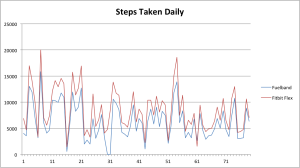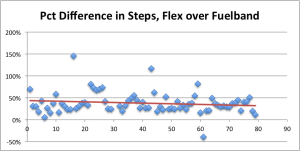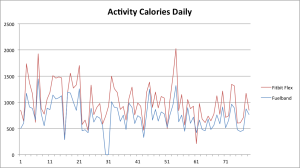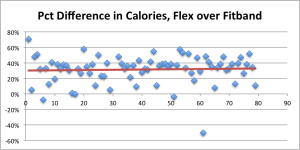I’ve been wearing a Nike Fuelband for the last year or so, since it first became commercially available. I added a Fitbit Flex three months ago, when it too first hit the market. They differ considerably — not just in design and intent, but in measuring what is supposedly the same thing.
The short version: over the course of the last three months, the Flex counted an average 37 percent more steps than the Fuelband does. The Flex also consistently counted about a 30 percent higher calorie burn.
The Flex’s higher figures are consistent across usage. That is, the devices do not seem to count differently on high-usage days or low-usage days. Given what are probably outlier days (one band or the other was in a charging dock or was getting replaced or was otherwise unavailable) the count difference clustered pretty closely to the trend line for both steps and calories.
There is an old Chinese proverb: “A man with one watch knows what time it is. A man with two watches is never sure.” The purpose of a fitness tracker is to, well, track fitness. Thirty-five percent is a pretty big margin of error; as good as the other functions may be, if a tracker can’t accurately track activity, it’s all but pointless.
The next move? Maybe I need to get an old-style pedometer and compare that to the Flex and Fuelband. Is there a Chinese saying: “A man with three watches may be just a little bit compulsive…”
The longer version:
Fuelband
The Nike Fuelband is a simple device with apparently modest goals: the track physical effort in the grossest measurement possible. It counts steps, attempts to estimate calories burned, and tries to assign a proprietary measurement of physical effort that it calls NikeFuel. Other Nike devices also generate NikeFuel measurement, and they presumably correlate with each other.
The device is physically beautiful and the interface is simple. My Fuelband is black (there are other finishes available), with a clasp on the back that both holds the band closed and hides a USB connector. There’s a button that toggles the LED display between several selections — Steps, Calories, Fuel, the watch — and various setup modes. Achieve your daily goal, and the LEDs animate. A strip of colored LEDs tells you how close you are to hitting your daily goal. Those goals though are denominated in NikeFuel, not anything so quotidian as steps or calories.
Nike claims not to do well with counting bicycling as athletic effort. It may not do it well, but it does do it. NikeFuel rates were higher after bike rides. Maybe it picks up vibrations in your arms.
The device is reasonably water-resistant. It stood up to swimming in a lake; a dip in the ocean probably fried it. I didn’t try it in a pool. Nike replaced it no questions asked.
The software — app and website — is attractive. Goals and streaks of consecutive days of goals being met are celebrated with cute animations in the app. You upload your results to the Nike Cloud either through your smartphone and app (over Bluetooth) or by plugging in your band to your computer. But even if you sync with your computer, you still need to sync the band with the app to get all your results on your phone. The band is the only way to tell your app to sync with the cloud.
There is no way to track anything else: just steps, calories, Fuel, and derived measures such as distance travelled and active minutes. And your data is Nike’s. There is no provision to download your data.
Fitbit Flex
The fit and finish on the Fitbit Flex is far less impressive than the Fuelband’s. The sensor is a piece of electronics about the 1. 5 inches long by 0.5 inches wide by 0.25 inches deep. It’s inserted into a flimsy rubber wristband that has an awkward clasp and that . The electronic module has a row of five white LEDs that show through a window in the wristband. It is sensitive to motion and touch, which is how you interact with the thing.
Data moves out of the device via Bluetooth 4.0, so it can more or less continually update your iPhone app (with an accompanying hit on your phone’s battery life). A small USB dongle comes with the Flex, to plug into your base computer; it, too, downloads data in the background. As near as I can tell, Fitbit keeps all data synced on all platforms without user interaction. To charge the Flex, you need to fit the Flex’s module into a special (lose-able) USB charger. That lets the core module be small, but adds another Thing to the package.
The Flex seems to be reasonably water resistant. I didn’t try it in a pool or ocean. The band, however, began to pull apart after just a few weeks, and replacements are very backordered. Bicycling hardly moved the needle at all. And there’s no clock on the Flex. You’ll miss the clock.
You also will never miss a button to push until you don’t have one. You interact with the Flex by tapping it firmly. Two taps will cause the LEDs to flash; the number of blinking light reflects how close you are to walking the doctor approved 10,000 steps. Tapping repeatedly will send the Flex into and out of the mode that tracks sleep activity. Everything else is handled through the app or website.
Tapping is a better idea than reality. Applause, for instance, will cycle the Flex into and out of sleep-tracking mode, and the thing vibrates when ever it changes mode. Going into sleep mode required whacking away at the thing with demented vigor. Or, apparently, applauding wildly. A button would really be better.
It’s all about the software
Where the Flex really shines is in the software, which is a reflection of the two products; ambitions. Nike is all about athletics — movement. It watches how much you move and how intensely, and that’s about it. Fitbit wants to be a total health tracker. You can use the app to track your food (read: caloric) and water intake, and the soundness of your sleep. Fitbit will also help you set up a food plan and, for $50/year, make coaching suggestions. The same $50 lets you download your data. It should be free, but $50 is better than not having access to it at all.
Comparative data
Here are some charts derived from my own data for the last three months. The first one shows the steps counted each day by the Flex and the Fuelband.
The second one tracks the difference between the two measures:
The third tracks the difference in calorie count. The Fuelband simply counts calories. The Flex keeps track of “activity calories” and “calories burned,” which appears to be total of resting metabolic rate and what you burn through movement. What’s presented here are “activity calories.”
And, because you can see that the Flex counts more calories than the Fuelband, the last graph shows how much more.
So you see: the Flex counts more of everything. The two products don’t even agree on how long a “step” is: by dividing the number of steps counted by the total daily distance claimed, it becomes apparent that the Flex thinks a “step” is about 29 inches; the Fuelband thinks it’s about 31 inches. (The Flex does let you adjust that figure.) That’s not a big difference, but over 10,000 steps, that’s about a third of a mile. The math aside, it would be nice if these two things were within, say, 15 percent of simply counting steps…
Bottom Line
So which one’s for you?
The Fuelband is elegant, but limited. The Flex’s software and ecosystem is enticing, but the device itself is kind of annoying. It’s worth noting that both products are on the verge of being revved; the Fuelband is gaining Bluetooth 4.0, and the Fitbit Force is gaining at least a button and a clock. We’ll review them when they arrive.
But the difference in step counts is still worrisome, because it’s at the heart of what these things purport to measure. Maybe they shouldn’t agree, but a consistent 35 percent delta is a problem.
If you just want to measure physical effort, go with the Fuelband, but know that you’re giving up easy access to your data. If you want a more complete fitness solution, it’s the Fitbit, but know that you’re giving up a certain amount of fit and finish.
For me, it’s off to find a pedometer.



